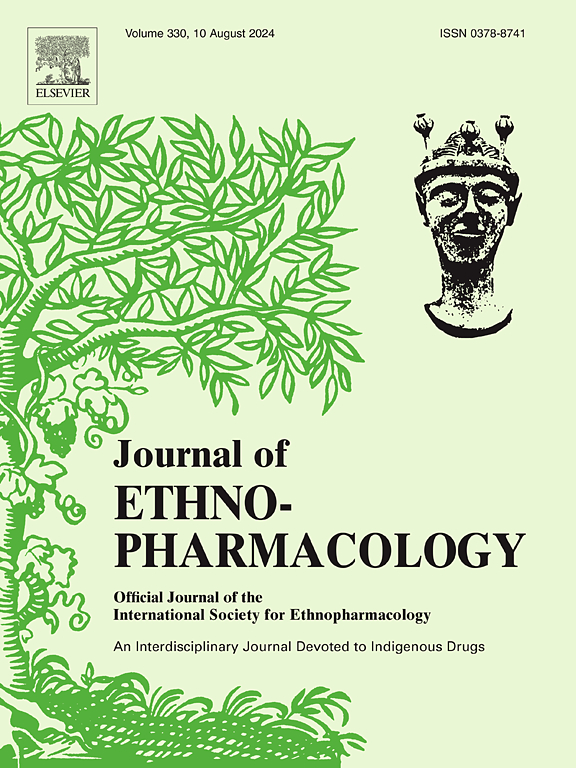Mechanistic analysis of anti-prostate cancer and toxicity-reducing effects of bufadienolides extracts: Comparative efficacy and safety with isolated bioactive compounds
IF 4.8
2区 医学
Q1 CHEMISTRY, MEDICINAL
引用次数: 0
Abstract
Ethnopharmacological relevance
Bufonis Venenum, a traditional ethnic drug, has shown potential efficacy in managing cancer, cardiovascular diseases, pain, and inflammation. Bufadienolides, its primary active constituents, exhibit potent antitumor activity.
Aim of the study
This study investigates the anti-prostate cancer and toxicity-reducing properties of bufadienolides extracts.
Materials and methods
The bufadienolides compounds were characterized using LC-MS/MS. Prostate cancer cells, normal prostate cells, and H9c2 cells were treated with bufadienolides extracts and its main compounds. Cell proliferation and migration were evaluated using MTT and scratch assays, while apoptosis and reactive oxygen species (ROS) production were measured by flow cytometry and the DCFH-DA fluorescence probe. Additionally, transcriptome-metabolomics analysis was employed to elucidate regulatory pathways, which were further verified by qRT-PCR and Western blot (WB). Bufadienolides' toxicity and antitumor effects were assessed using acute toxicity assays and an H22 tumor-bearing mouse model.
Results
Apart from eight bufadienolides compounds, the formation of aggregates, such as dimers of monomeric compounds, was identified within the extracts. Bufadienolides extracts and its major components, bufalin and resibufogenin, significantly inhibited prostate cancer cell proliferation and migration, induced apoptosis, and promoted ROS production. They modulated key biological processes, including IL-17, TNF, MAPK, and mTOR signaling, lipid metabolism, and pantothenate and CoA biosynthesis. Notably, extracts exhibited superior efficacy compared to bufalin and resibufogenin in both in vitro and in vivo experiments.
Conclusion
The combined action of multiple bufadienolides in the extract may enhance their overall efficacy and safety, highlighting their potential as therapeutic agent for prostate cancer.

蟾法二烯内酯提取物抗前列腺癌和降毒作用的机制分析:与分离的生物活性化合物的疗效和安全性比较
民族药物学相关性蟾毒是一种传统的民族药物,在治疗癌症、心血管疾病、疼痛和炎症方面显示出潜在的功效。其主要活性成分蟾二烯内酯具有很强的抗肿瘤活性。目的研究蟾二烯内酯提取物的抗前列腺癌和降毒作用。材料与方法采用LC-MS/MS对化合物进行表征。用丁二烯内酯提取物及其主要化合物处理前列腺癌细胞、正常前列腺细胞和H9c2细胞。采用MTT和划痕法检测细胞增殖和迁移,采用流式细胞术和DCFH-DA荧光探针检测细胞凋亡和活性氧(ROS)产生。此外,利用转录组-代谢组学分析阐明调控途径,并通过qRT-PCR和Western blot (WB)进一步验证。采用急性毒性试验和H22荷瘤小鼠模型评价蟾二烯内酯的毒性和抗肿瘤作用。结果除8种丁二烯内酯类化合物外,提取物中还存在单体化合物二聚体等聚集体。蟾毒二烯内酯提取物及其主要成分蟾毒灵和脂蟾毒素显著抑制前列腺癌细胞的增殖和迁移,诱导细胞凋亡,促进ROS的产生。它们调节关键的生物过程,包括IL-17、TNF、MAPK和mTOR信号、脂质代谢以及泛酸和辅酶a的生物合成。值得注意的是,在体外和体内实验中,提取物均表现出优于蟾毒灵和resbufogenin的功效。结论多种丁二烯内酯的联合作用可提高其整体疗效和安全性,显示出其作为前列腺癌治疗药物的潜力。
本文章由计算机程序翻译,如有差异,请以英文原文为准。
求助全文
约1分钟内获得全文
求助全文
来源期刊

Journal of ethnopharmacology
医学-全科医学与补充医学
CiteScore
10.30
自引率
5.60%
发文量
967
审稿时长
77 days
期刊介绍:
The Journal of Ethnopharmacology is dedicated to the exchange of information and understandings about people''s use of plants, fungi, animals, microorganisms and minerals and their biological and pharmacological effects based on the principles established through international conventions. Early people confronted with illness and disease, discovered a wealth of useful therapeutic agents in the plant and animal kingdoms. The empirical knowledge of these medicinal substances and their toxic potential was passed on by oral tradition and sometimes recorded in herbals and other texts on materia medica. Many valuable drugs of today (e.g., atropine, ephedrine, tubocurarine, digoxin, reserpine) came into use through the study of indigenous remedies. Chemists continue to use plant-derived drugs (e.g., morphine, taxol, physostigmine, quinidine, emetine) as prototypes in their attempts to develop more effective and less toxic medicinals.
 求助内容:
求助内容: 应助结果提醒方式:
应助结果提醒方式:


